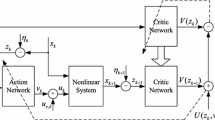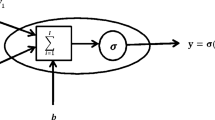Abstract
This paper proposes a novel finite-time optimal control method based on input–output data for unknown nonlinear systems using adaptive dynamic programming (ADP) algorithm. In this method, the single-hidden layer feed-forward network (SLFN) with extreme learning machine (ELM) is used to construct the data-based identifier of the unknown system dynamics. Based on the data-based identifier, the finite-time optimal control method is established by ADP algorithm. Two other SLFNs with ELM are used in ADP method to facilitate the implementation of the iterative algorithm, which aim to approximate the performance index function and the optimal control law at each iteration, respectively. A simulation example is provided to demonstrate the effectiveness of the proposed control scheme.









Similar content being viewed by others
References
Bellman RE (1957) Dynamic programming. Princeton University Press, Princeton
Duncan TE, Guo L, Pasik-Duncan B (1999) Adaptive continuous-time linear quadratic gaussian control. IEEE Trans Autom Control 44(9):1653–1662
Fernández-Navarro F, Hervás-Martínez C, Gutierrez PA (2013) Generalised Gaussian radial basis function neural networks. Soft Comput 17:519–533
Gabasov R, Kirillova FM, Balashevich NV (2000) Open-loop and closed-loop optimization of linear control systems. Asian J Control 2(3):155–168
Guardabassi GO, Savaresi SM (May 2000) Virtual reference direct design method: an off-line approach to data-based control system design. IEEE Trans Autom Control 45(5):954–959
He P, Jagannathan S (2007) Reinforcement learning neural-network-based controller for nonlinear discrete-time systems with input constraints. IEEE Trans Syst Man Cybern Part B: Cybern 37(2):425–436
Hornik K (1991) Approximation capabilities of multilayer feedforward networks. Neural Netw 4:251–257
Huang G-B (2003) Learning capability and storage capacity of two-hidden-layer feedforward networks. IEEE Trans Neural Netw 14(2):274–281
Huang G-B, Siew C-K (2004) Extreme learning machine: RBF network case. In: The Proceedings of the eighth international conference on control, automation, robotics and vision (ICARCV 2004), vol 2. Kunming, Dec 6–9. p 1029–1036
Huang G-B, Zhu Q-Y, Siew C-K (2006a) Extreme learning machine: theory and applications. Neurocomputing 70:489–501
Huang G-B, Chen L, Siew C-K (2006b) Universal Approximation Using Incremental Constructive Feedforward Networks with Random Hidden Nodes. IEEE Trans Neural Netw 17(4):879–892
Huang G-B, Wang DH, Lan Y (2011) Extreme learning machines: a survey. Int J Mach Learn Cybern 2(2):107–122
Jagannathan S (2006) Neural network control of nonlinear discrete-time systems. CRC Press, Boca Raton
Jin X, Yang G, Peng L (2012) Robust adaptive tracking control of distributed delay systems with actuator and communication failures. Asian J Control 14(5):1282–1298
Leshno M, Lin VY, Pinkus A, Schocken S (1993) Multilayer feedforward networks with a nonpolynomial activation function can approximate any function. Neural Netw 6:861–867
Liu D, Zhang H (2005) A neural dynamic programming approach for learning control of failure avoidance problems. Int J Intell Control Syst 10(1):21–32
Liu D, Wei Q (2013) Finite-approximation-error-based optimal control approach for discrete-time nonlinear systems. IEEE Trans Syst Man Cybern Part B: Cybern 43(2):779–789
Maji K, Pratihar DK, Nath AK (2013) Analysis and synthesis of laser forming process using neural networks and neuro-fuzzy inference system. Soft Comput 17:849–865
Murray JJ, Cox CJ, Lendaris GG, Saeks R (2002) Adaptive dynamic programming. IEEE Trans Syst Man Cybern Part C: Appl Rev 32(2):140–153
Richert D, Masaud K, Macnab CJB (2013) Discrete-time weight updates in neural-adaptive control. Soft Comput 17:431–444
Seiffertt J, Sanyal S, Wunsch DC (2008) Hamilton-Jacobi-Bellman equations and approximate dynamic programming on time scales. IEEE Trans Syst Man Cybern Part B: Cybern 38(4):918–923
Song R, Zhang H (2013) The finite-horizon optimal control for a class of time-delay affine nonlinear system. Neural Comput Appl 22(2):229–235
Song R, Zhang H, Luo Y, Wei Q (2010) Optimal control laws for time-delay systems with saturating actuators based on heuristic dynamic programming. Neurocomputing 73(16–18):3020–3027
Tamura S, Tateishi M (1997) Capabilities of a fourlayered feedforward neural network: four layers versus three. IEEE Trans Neural Netw 8(2):251–255
Wang F, Jin N, Liu D, Wei Q (2011) Adaptive dynamic programming for finite-horizon optimal control of discrete-time nonlinear systems with \(\epsilon \)-error bound. IEEE Trans Neural Netw 22:24–36
Wei Q, Liu D (2012) An iterative \(\varepsilon \)-optimal control scheme for a class of discrete-time nonlinear systems with unfixed initial state. Neural Netw 32:236–244
Werbos PJ (1992) Approximate dynamic programming for real-time control and neural modeling, chap. 13. In: White DA, Sofge DA (eds) Handbook of intelligent control: neural, fuzzy, and adaptive approaches. Van Nostrand Reinhold, New York
Werbos PJ (2008) ADP: The key direction for future research in intelligent control and understanding brain intelligence. IEEE Trans Syst Man Cybern Part B: Cybern 38(4):898–900
Yu W (2009) Recent advances in intelligent control systems. Springer-Verlag, London
Zhang R, Huang G-B, Sundararajan N, Saratchandran P (2007) Multi-category classification using extreme learning machine for microarray gene expression cancer diagnosis. IEEE/ACM Trans Comput Biol Bioinform 4(3):485–495
Zhang H, Wei Q, Luo Y (2008) A novel infinite-time optimal tracking control scheme for a class of discrete-time nonlinear systems via the greedy HDP iteration algorithm. IEEE Trans Syst Man Cybern Part B: Cybern 38(4):937–942
Zhang H, Cui L, Zhang X, Luo Y (2011a) Data-Driven Robust Approximate Optimal Tracking Control for Unknown General Nonlinear Systems Using Adaptive Dynamic Programming Method. IEEE Trans Neural Netw 22(12):2226–2236
Zhang H, Wei Q, Liu D (2011b) An iterative adaptive dynamic programming method for solving a class of nonlinear zero-sum differential games. Automatica 47(1):207–214
Zhang H, Song R, Wei Q (2011c) Optimal tracking control for a class of nonlinear discrete-time systems with time delays based on heuristic dynamic programming. IEEE Trans Neural Netw 22(12):1851–1862
Zhang H, Wei Q, Liu D (2011d) An iterative adaptive dynamic programming method for solving a class of nonlinear zero-sum differential games. Automatica 47(1):207–214
Zhang H, Song R, Wei Q, Zhang T (2011e) Optimal tracking control for a class of nonlinear discrete-time systems with time delays based on heuristic dynamic programming. IEEE Trans Neural Netw 22(12):1851–1862
Zhao Y, Patek SD, Beling PA (2008) Decentralized Bayesian search using approximate dynamic programming methods. IEEE Trans Syst Man Cybern Part B: Cybern 38(4):970–975
Acknowledgments
This work was supported in part by the Open Research Project from SKLMCCS (Grant no. 20120106), the Fundamental Research Funds for the Central Universities (Grant no. FRF-TP-13-018A), the China Postdoctoral Science Foundation (Grant no. 2013M530527), and the National Natural Science Foundation of China (Grants no. 61304079, 61125306, 61034002, 61374105), and Beijing Natural Science Foundation (Grant no. 4132078).
Author information
Authors and Affiliations
Corresponding author
Additional information
Communicated by D. Liu.
Rights and permissions
About this article
Cite this article
Song, R., Xiao, W., Wei, Q. et al. Neural-network-based approach to finite-time optimal control for a class of unknown nonlinear systems. Soft Comput 18, 1645–1653 (2014). https://doi.org/10.1007/s00500-013-1170-z
Published:
Issue Date:
DOI: https://doi.org/10.1007/s00500-013-1170-z




